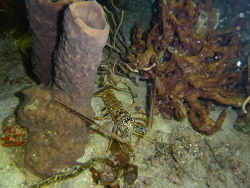Info
Panulirus argus (Latreille, 1804)
Panulirus argus, the Caribbean spiny lobster, is a species of spiny lobster that lives on reefs and mangrove swamps in the western Atlantic.
The Caribbean spiny lobster has long, cylindrical bodies covered in spines. Two large spines form forward-facing “horns” above the eyestalks. They are generally olive green or brown, but can also be brown to mahogany in color. There are scattered yellowish to cream spots on the carapace and larger (usually four to six) yellow to cream spots on the abdomen. They have a pair of antennae that are longer than the body and covered in forward-facing spines. The base of the second antennae is thick, can be bluish in color and is also covered with rows of spines. The legs are usually longitudinally striped blue and yellow.
Panulirus argus can reach a length of up to 60 cm, but usually remains significantly smaller at 20 cm. The lobster is fished throughout its entire distribution area. Females reach sexual maturity at a carapace length of 54–80 mm.
Like most decapods, Panulirus argus hatches from the eggs carried by the female after about four weeks. They begin life as free-swimming, microscopic phyllosoma larvae. After about a year, the larvae settle in algae (Laurencia sp., Neogoniolithon sp.), in Thalassia testudinum seagrass beds or between mangrove roots. After several molts, they migrate to coral reefs and live in holes or crevices.
Panulirus argus is a nocturnal species that hides during the day. Although they generally prefer to stay under cover, groups of hundreds of spiny lobsters sometimes gather and march across the terrain off Florida and the Bahamas. The purpose of these hikes is unknown. However, these generally occur in the fall and could be a response to the onset of fall storms.
They prefer habitats in which they can hide such as coral reefs, artificial reefs, sponges, bridge pilings, wooden bridge bumpers, piers and under the buttress roots of mangroves.
Gastropods, beetle snails, mussels and carrion are part of this species' diet. It is also known to eat lobsters, sea urchins, worms, crustaceans and some types of "marine vegetation". She herself is fed by rays, nurse sharks, octopuses, snappers and groupers.
Human consumption:
Panulirus argus is a popular seafood product for human consumption and is the Bahamas' primary food export, competing in commercial value with the Florida Keys shrimp industry. They are fished by both commercial lobstermen and recreational divers in South Florida, the Caribbean, the Bahamas and Bermuda.
Synonymised names:
Palinurus argus Latreille, 1804 (basionym)
Panulirus argus westonii Sarver, Silberman & Walsh, 1998 (nomen nudum)
Panulirus argus, the Caribbean spiny lobster, is a species of spiny lobster that lives on reefs and mangrove swamps in the western Atlantic.
The Caribbean spiny lobster has long, cylindrical bodies covered in spines. Two large spines form forward-facing “horns” above the eyestalks. They are generally olive green or brown, but can also be brown to mahogany in color. There are scattered yellowish to cream spots on the carapace and larger (usually four to six) yellow to cream spots on the abdomen. They have a pair of antennae that are longer than the body and covered in forward-facing spines. The base of the second antennae is thick, can be bluish in color and is also covered with rows of spines. The legs are usually longitudinally striped blue and yellow.
Panulirus argus can reach a length of up to 60 cm, but usually remains significantly smaller at 20 cm. The lobster is fished throughout its entire distribution area. Females reach sexual maturity at a carapace length of 54–80 mm.
Like most decapods, Panulirus argus hatches from the eggs carried by the female after about four weeks. They begin life as free-swimming, microscopic phyllosoma larvae. After about a year, the larvae settle in algae (Laurencia sp., Neogoniolithon sp.), in Thalassia testudinum seagrass beds or between mangrove roots. After several molts, they migrate to coral reefs and live in holes or crevices.
Panulirus argus is a nocturnal species that hides during the day. Although they generally prefer to stay under cover, groups of hundreds of spiny lobsters sometimes gather and march across the terrain off Florida and the Bahamas. The purpose of these hikes is unknown. However, these generally occur in the fall and could be a response to the onset of fall storms.
They prefer habitats in which they can hide such as coral reefs, artificial reefs, sponges, bridge pilings, wooden bridge bumpers, piers and under the buttress roots of mangroves.
Gastropods, beetle snails, mussels and carrion are part of this species' diet. It is also known to eat lobsters, sea urchins, worms, crustaceans and some types of "marine vegetation". She herself is fed by rays, nurse sharks, octopuses, snappers and groupers.
Human consumption:
Panulirus argus is a popular seafood product for human consumption and is the Bahamas' primary food export, competing in commercial value with the Florida Keys shrimp industry. They are fished by both commercial lobstermen and recreational divers in South Florida, the Caribbean, the Bahamas and Bermuda.
Synonymised names:
Palinurus argus Latreille, 1804 (basionym)
Panulirus argus westonii Sarver, Silberman & Walsh, 1998 (nomen nudum)







 NOAA Flower Garden Banks National Marine Sanctuary
NOAA Flower Garden Banks National Marine Sanctuary























